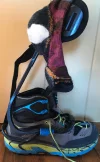
Individually held preferences are something which cannot and should not be debated. Folks have a right to make choices based on whatever criteria they believe is important to them. To that end, I want to say that whatever your reason for wanting boots, flip-flops, bare feet, sandals, trail runners, etc. do not feel that you must change your decisions based on what 'everyone else' does. Be comfortable with your choice.
That being said, if there are statements or observations made in a forum post as a reason to support a choice, then I think that it is important to make sure that any stated 'facts' are actually 'facts'.
Such is the case with footwear. It is not my intention to offend anyone, as I believe that there are times and situations where boots are a reasonable choice to make when hiking, backpacking, or walking. I own and use a pair of Lowa Camino boots in certain seasons and weather conditions in the mountains when backpacking.
However, there a lot of people on this forum looking for answers about footwear and want to make decisions based on what is factual criteria. If looking at boots as a footwear choice, ankle support is not a reason to do so.
As to the long held idea that boots provide ankle support, long term studies and research have shown this to be not quite the case.
First, unless there are specific and diagnosed medical issues, the ankle is best protected with exercise and use, where the ankle is allowed to use uneven surfaces, exercise, and balancing on one foot in order to build strength and endurance and lessen susceptibility to injurious fatigue.
The only sure and viable ankle support for those with such a medically indicated need, are ankle braces which can fit inside of the shoe or boot. Despite anecdotal evidence and subjective opinion to the contrary, research has repeatedly shown that boots by themselves do not provide the level of stiffness and the shear rigidity needed to keep ankles free from injury.
They can, in fact, exacerbate the risk of injury.
A foot in a boot is sitting higher off the ground than when in a shoe because the outer and mid-soles are much thicker and built up. Additionally, the outer sole of boots are trimmed closer to shell of the boot, meaning that the outer sole has a fairly narrow profile. Both of these factors have been shown to have a higher risk of the footwear 'rolling' when stepping on an unstable surface or piece of debris like loose rocks or uneven surfaces.
As the boot begins to roll, the boot carries the foot with it, the higher material of the boot above the ankle exerts more force against the foot to make it roll with the boot. That material is not stiff enough to keep from flexing, which means that your ankle is going to start bending as the roll of the boot continues. And because the foot is higher off the ground inside the boot, the ankle can be forced into a more significant bending.
Another factor about boots that helps lead to injury is their weight. The heavier the weight that the foot and lower legs need to lift, the more stress and fatigue the ankles and supporting structures are exposed to. Such weakens the ability of the ankle structures to maintain resiliency.
Trail shoes and trail runners, on the other hand, do the opposite when confronted with the same type of uneven surface or debris. The outer and midsoles are much closer to the ground. They are also wider than the shoe making for a contact point with the ground that is more stable. Their much lighter weight keeps ankle structures from fatiguing.
Now here is the thing researchers found as most significant: A foot in a shoe that is kept a bit loose can compensate, to a large degree, when the shoe starts to roll off of an uneven surface. As the shoe rolls, the shoe tends to slip
around the foot. In other words, the shoe moves
around the foot for the most part, so the ankle won't immediately bend out of place with the shoe. This allows the wearer of the shoe to have enough time to react to the rolling and twisting shoe to keep the ankle from injurious strain.
Yes, there are people who get ankle injuries in trail shoes and trail runners. But those injuries are less frequent and less severe, on an average, than with a foot encased in an above the ankle hiking boot.
As I stated above, there will be any number of folks that, with no predisposing medical conditions, will state anecdotal evidence along the lines that they, or a friend, or other family members, et al, were saved by above the ankle boots. Subjective opinion is like that.

But objective evidence begs to differ on the best way of protecting ankles and the lower leg structures.























